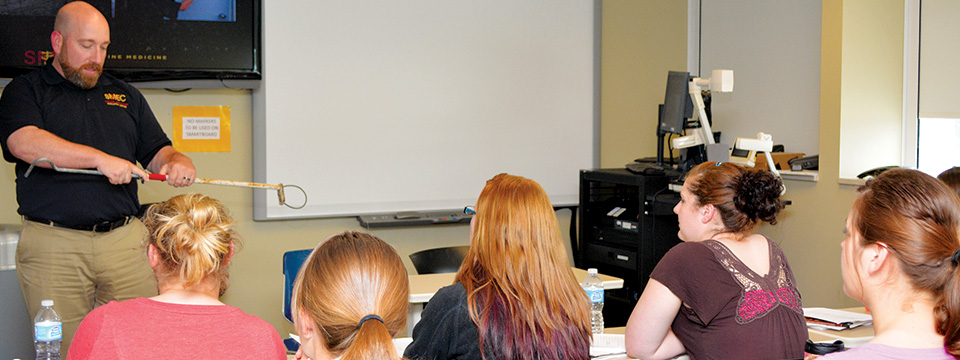
Teaching is so much a part of Dr. Locke Karriker’s professional life that even his office in the College of Veterinary Medicine has its own little classroom.
Three 8-foot tables are shoved together creating a space where the associate professor of veterinary diagnostic and animal production medicine can meet with groups of students.
Even Karriker is a little surprised to find a “mini-classroom” in his office.
“It certainly wasn’t a part of any plan I had,” Karriker says. “My original contract with Iowa State stated 85 percent of my time was to be spent on research.”
While Karriker is still an active researcher, teaching has consumed more and more of his time. Shortly after he joined the veterinary medicine faculty, a key faculty member departed, leaving Karriker as “the only remaining option to teach some of these courses.”
Soon he found out he was much better at teaching than research and the rest, as they say, is history. Karriker has become such an effective teacher he was the recipient this year of the Iowa State University Award for Outstanding Achievement in Teaching.
His department chair describes him as a “franchise player…a triple threat,” but “first and foremost, a teacher.”
Karriker is a teacher no matter where he is – in his makeshift office classroom or out in a swine facility where he says he draws pictures in the dirt to help his students better understand a subject.
“I enjoy learning things that have purpose and utility,” he said. “I believe then it is natural for me to want to pass along that knowledge.”
Karriker passes along knowledge in any number of educational situations including at Iowa State’s Swine Medicine Education Center (SMEC). Karriker has been the director of the facility since its creation in 2011 and has helped the center gain national and international attention as the place for teaching and learning evidence based swine production medicine.
The facility has attracted veterinary students from 19 other schools in North America, while students from 29 other countries have taken modules, courses or visited in the past four years.
“To be honest, there is a lot less swine medicine teaching going on at the other veterinary schools in the country,” Karriker said. “Iowa State should be and is the leader in swine medicine, so it was natural to create SMEC, which is a sustainable mechanism that will continue to build on our momentum.”
Since SMEC’s launch in 2011, nine new courses have been developed and the staff has expanded from one (Karriker) to a full time program assistant and four post-docs. These staff members have created almost 60 in-house training videos that are distributed to veterinary schools on-line. The videos were created in part thanks to a three-year, $700,000 USDA Challenge Grant awarded to Karriker.
“These videos have made a huge difference in the rate of growth in our programs,” he said. “The grant has allowed us to focus on building curriculum and content.”
Not to mention give Karriker another avenue in which to teach.
October 2015
